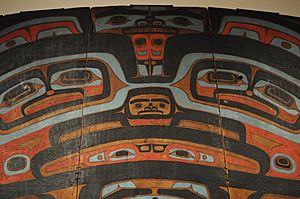Formline art facts for kids

Formline art is a special style of art from the Northwest Coast of North America. It's used by many Indigenous peoples in their paintings, carvings, and designs. This art style is known for its unique shapes called ovoids, U forms, and S forms.
A scholar named Bill Holm first described "formline" in his 1965 book, Northwest Coast Indian Art: An Analysis of Form. He explained that formlines are the main building blocks of this art. They are continuous, flowing lines that curve and change thickness in a specific way. Artists use them to create outlines of figures, design elements inside those figures, and even abstract patterns.
A Look at History
After Europeans arrived in the late 1700s, the Indigenous peoples of the Northwest Coast faced many challenges. Diseases like smallpox caused huge population loss. Their cultures also suffered due to forced changes and the destruction of traditional art. This led to a big drop in the creation of their unique art.
Art for Sale
By the late 1800s, Northwest Coast artists began making art for sale. For example, the Haida created small carvings from a dark stone called argillite. During this time, many traditional art pieces, like totem poles and masks, were also sent to museums and collectors around the world. Sometimes, the artists or communities were paid for these items, and sometimes they were not.
The Art Revival
In the early 1900s, very few First Nations artists were still making traditional Northwest Coast art. However, a few artists like Charles Gladstone (Haida), Stanley George (Heiltsuk), and Mungo Martin (Kwakwaka'wakw) kept the old traditions alive.
By the mid-1900s, there was a new interest in Northwest Coast art. Artists and experts like Bill Reid, who was Charles Gladstone's grandson, helped bring this art form back to life. This art revival was part of a larger cultural awakening among First Nations communities.
Bringing Art Home
During this time, there was also a growing demand for the return of art objects. Many pieces had been taken from First Nations communities without permission. This movement, called Repatriation, continues today. Now, many art schools teach traditional Northwest Coast art styles. There is also a growing market for new art created in this amazing style.
See also

